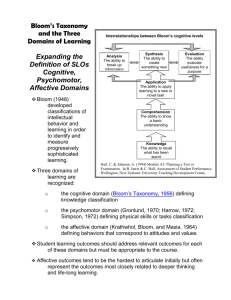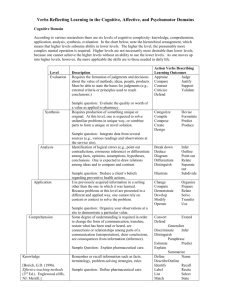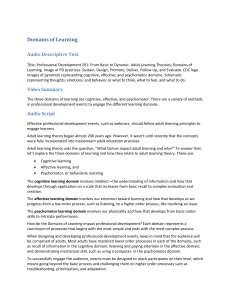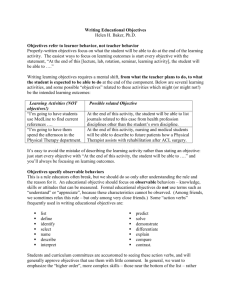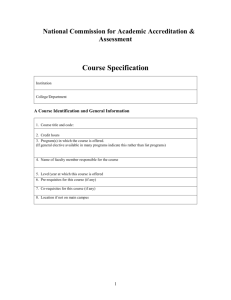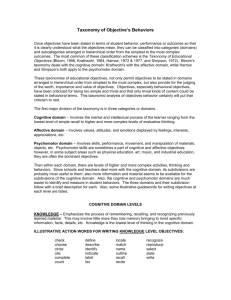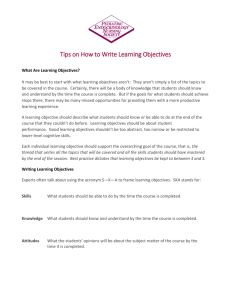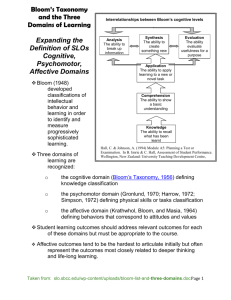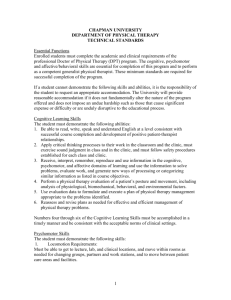Write Effective Learning Outcomes
advertisement
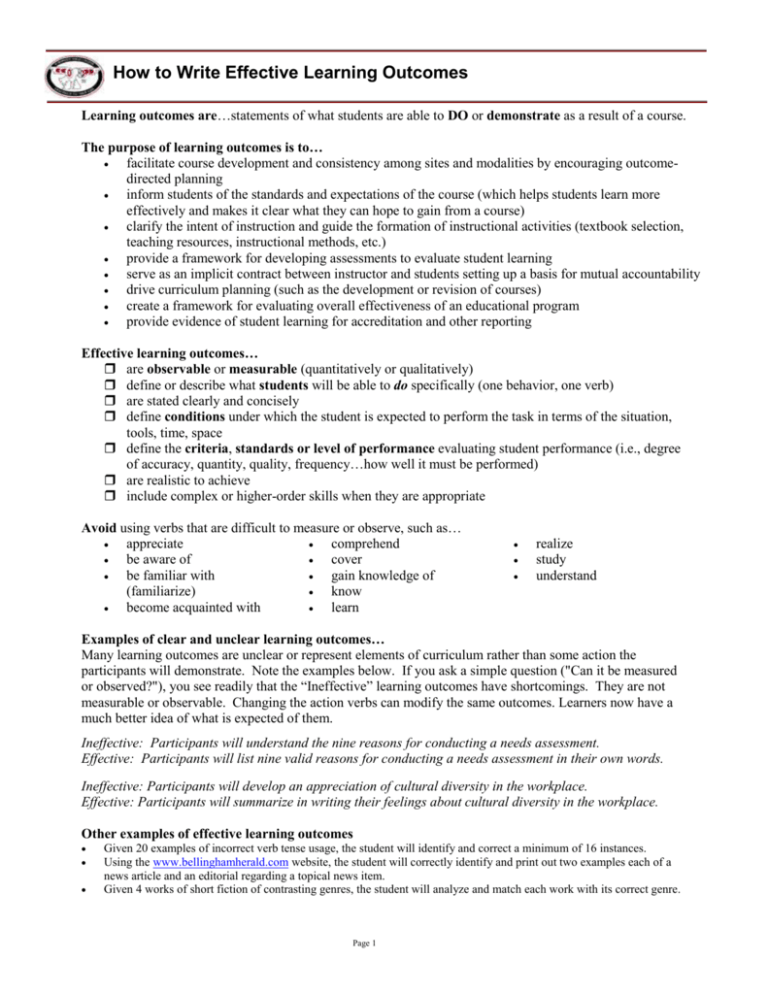
How to Write Effective Learning Outcomes Learning outcomes are…statements of what students are able to DO or demonstrate as a result of a course. The purpose of learning outcomes is to… facilitate course development and consistency among sites and modalities by encouraging outcomedirected planning inform students of the standards and expectations of the course (which helps students learn more effectively and makes it clear what they can hope to gain from a course) clarify the intent of instruction and guide the formation of instructional activities (textbook selection, teaching resources, instructional methods, etc.) provide a framework for developing assessments to evaluate student learning serve as an implicit contract between instructor and students setting up a basis for mutual accountability drive curriculum planning (such as the development or revision of courses) create a framework for evaluating overall effectiveness of an educational program provide evidence of student learning for accreditation and other reporting Effective learning outcomes… are observable or measurable (quantitatively or qualitatively) define or describe what students will be able to do specifically (one behavior, one verb) are stated clearly and concisely define conditions under which the student is expected to perform the task in terms of the situation, tools, time, space define the criteria, standards or level of performance evaluating student performance (i.e., degree of accuracy, quantity, quality, frequency…how well it must be performed) are realistic to achieve include complex or higher-order skills when they are appropriate Avoid using verbs that are difficult to measure or observe, such as… appreciate comprehend be aware of cover be familiar with gain knowledge of (familiarize) know become acquainted with learn realize study understand Examples of clear and unclear learning outcomes… Many learning outcomes are unclear or represent elements of curriculum rather than some action the participants will demonstrate. Note the examples below. If you ask a simple question ("Can it be measured or observed?"), you see readily that the “Ineffective” learning outcomes have shortcomings. They are not measurable or observable. Changing the action verbs can modify the same outcomes. Learners now have a much better idea of what is expected of them. Ineffective: Participants will understand the nine reasons for conducting a needs assessment. Effective: Participants will list nine valid reasons for conducting a needs assessment in their own words. Ineffective: Participants will develop an appreciation of cultural diversity in the workplace. Effective: Participants will summarize in writing their feelings about cultural diversity in the workplace. Other examples of effective learning outcomes Given 20 examples of incorrect verb tense usage, the student will identify and correct a minimum of 16 instances. Using the www.bellinghamherald.com website, the student will correctly identify and print out two examples each of a news article and an editorial regarding a topical news item. Given 4 works of short fiction of contrasting genres, the student will analyze and match each work with its correct genre. Page 1 The Three Learning Domains Depending on the course goals, learning outcomes may fall into one of three domains: cognitive, psychomotor, or affective. Will the students be acquiring knowledge (cognitive), developing physical skills (psychomotor) or developing values, ethics, or attitudes (affective)? A college education addresses all of these domains, but various courses and programs are focused more on some domains than others. Examine what knowledge, skills, and attitudes are necessary and significant for the students to acquire during your course. Bloom’s (1956) taxonomy of learning differentiates between the following three domains of learning: 1. The Cognitive Domain (mind/head): targets knowledge and intellectual skills 2. The Affective Domain (spirit/heart): targets attitudes, interests, feelings, values, and ethics 3. The Psychomotor Domain (body/hands): targets physical and manipulation skills The major categories of each domain are described briefly in order, from the simplest ability level to the most complex. Use this list to help select verbs to express distinct performance expectations you have of your students and to create learning outcomes. 1. The Cognitive Domain (mind) Most courses in higher education focus on the cognitive domain (i.e., knowledge and the development of intellectual skills); thus it is important to examine various levels of cognitive understanding. This domain is broken-down into six categories: it begins with knowledge level learning and advances up the taxonomy to comprehension, application, and then the higher order skills involved in analysis, synthesis, and evaluation or problem solving. Generally, instructors will want to design learning outcomes to target a range of levels of student understanding. The phrasing of learning outcomes will help guide both instructional activities and assessment, thus instructors should carefully select the emphasis of learning and the relevant verb. The categories represent degrees of difficulty (i.e., the first one must be mastered before the next one can take place). Level I: Knowledge—the student recognizes and recalls facts and specifics (e.g., Students will list the seasons in order; also, dates, events, places, vocabulary, key ideas, parts of diagram) Level II: Comprehension—the student interprets, translates, summarizes, or paraphrases given information. Requires knowledge in order to demonstrate comprehension (e.g., Students will define "justice" in their own words; also, find meaning, transfer, interpret facts, infer cause and consequence, give examples) Level III: Application—the student uses information in a situation different from the original learning context. Requires comprehension of information to be able to apply in a new situation (e.g., Students will use a math formula to solve a problem) Level IV: Analysis—the student separates the whole into its parts, until relationships among elements are clear; requires the ability to apply information in order to analyze (e.g., Students will reorder the sentences to form a proper paragraph; also, recognize and explain patterns / meaning) Level V: Synthesis— the student combines elements to form new entities from the original one. Requires analysis in order to synthesize (e.g., Students will construct an hypothesis that explains the observed phenomenon; also, discuss "what if" situations, create new ideas, predict and draw conclusions) Level VI: Evaluation—the student is involved in acts of decision-making, problem-solving, judging, or selecting based on criteria and rationale; requires synthesis in order to evaluate (e.g., Students will critique a poem using accepted criteria; also, make recommendations, assess value and make choices) Page 2 List of verbs for the cognitive domain Knowledge arrange choose complete count define describe draw duplicate identify indicate know label list match memorize name order outline point quote read recall recite recognize record repeat reproduce restate retain select state write Comprehension Application associate characterize classify complete compute convert defend depict describe discuss distinguish establish estimate explain express extend extrapolate generalize give example identify illustrate infer locate paraphrase predict recognize relate report review rewrite sort summarize translate add administer apply calculate change choose classify complete compute conduct demonstrate discover divide dramatize employ examine graph implement interpolate interpret manipulate modify operate perform practice prepare prescribe produce role play show sketch solve subtract translate use Page 3 Analysis analyze appraise arrange breakdown categorize combine compare contrast critique design detect develop diagram differentiate discriminate distinguish examine experiment explore illustrate infer inventory investigate outline point out question relate research select separate subdivide test utilize Synthesis categorize combine compile compose consolidate construct create design devise drive explain formulate generate group hypothesize integrate merge modify order organize plan prescribe propose rearrange reconstruct relate reorganize revise rewrite specify summarize synthesize systematize theorize transform unite write Evaluation appraise arbitrate argue assess award compare conclude contrast criticize critique decide defend determine envision estimate evaluate examine grade inspect interpret judge justify measure prioritize rank rate recommend referee review support test value 2. The Affective Domain (heart/spirit) This domain includes the manner in which students deal with things emotionally, such as feelings, values, appreciation, enthusiasms, motivations, and attitudes. The five major categories listed in order are… Level I: Receiving—students show awareness of the benefits of a particular value, attitude or interest; receiving is concerned with holding and directing the student’s attention (e.g., the student listens attentively) accept differences ask describe identify show sensitivity of attend closely to follow listen attentively tolerate acknowledge choose give reply Level II: Responding—refers to active participation on the part of the student (e.g., the student willingly answers questions) agree (to) conform greet pursue seek answer consent help question select ask contribute indicate react show interest in assist cooperate inquire read show preference communicate discuss label reply visit complete enjoy helping others obey rules report volunteer for assignments exhibit participate in request comply follow-up discussions respond Level III: Valuing—the student sees personal worth in a value, belief, attitude, or interest (assignment); displays behaviour in situations where s/he is not forced to comply or obey (e.g., the student expresses strong opinions on issues under discussion) accept demonstrate belief differentiate integrate sanction adhere to in or commitment display invite select adopt to endorse join share approve demonstrate exhibit justify show concern for choose problem-solving explain prefer work commit attitude express propose complete describe form read desire initiate report Level IV: Organizing—the student is committed to building a set of values as displayed by behaviour (e.g., the student criticizes arguments and positions presented in class) accept classify formulate a plan organize relate responsibility for combine generalize perform resolve adapt compare group prepare solve adhere complete identify rank synthesize alter defend integrate rate systemize arrange establish modify recognize the weigh alternatives categorize explain order need for / role of Level V: Internalizing—the student’s total behaviour is consistent with internalized values (e.g., the student demonstrates self-reliance in working independently) act punctuality, self- exemplify perform serve advocate discipline, and function practice co-operation support behave self-reliance incorporate in uphold characterize devote influence preserve use objective conform disclose justify propose approach in continue discriminate listen qualify problem solving defend display maintain question demonstrate encourage modify retain industry, endure pattern revise Page 4 3. The Psychomotor Domain (body) The psychomotor domain includes physical movement, coordination, and use of the motor-skill areas. Development of these skills requires practice and is measured in terms of speed, precision, distance, procedures, or techniques in execution. The major categories listed in order are… Level I: Imitation—The student observes skills and attempts to repeat them. assemble attempt carry out copy calibrate construct dissect duplicate follow mimic move practice proceed repeat reproduce respond organize sketch start try volunteer Level II: Manipulation—The student continues to practice a particular skill or sequence until it becomes habitual and the action can be performed with some confidence and proficiency. The response is more complex than at the previous level, but the learner still is not sure of him/herself. same as level I acquire assemble complete conduct do execute improve maintain make manipulate operate pace perform produce progress use Level III: Precision—The student reproduces a skill with accuracy, proportion, and exactness, requiring a minimum of energy; usually performed without hesitation. same as level I and II achieve accomplish advance automatize exceed excel master reach refine succeed surpass transcend Level IV: Articulation—involves an even higher level of precision. The skills are so well developed that the student can modify movement patterns to fit special requirements or to meet a problem situation. adapt alter change excel rearrange reorganize revise surpass transcend Level V: Naturalization—The student’s response is automatic. The student begins to experiment, creating new motor acts or ways of manipulating materials out of understandings, abilities, and skills developed. The student acts "without thinking" (e.g., the student will develop a new and comprehensive training programming or create a new gymnastics routine). arrange create transcend combine design compose refine construct originate Page 5
